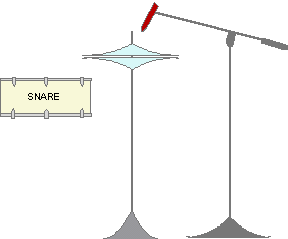Recording with a microphone on the hi-hat and the ride cymbal is something that is recommended by Chris Sheldon, who produced the three Biffy Clyro tracks in my influences playlist, but is something that I have not really done in my last few drum recording sessions. Given that my first learning outcome is to improve on the quality of my drum recordings compared to previous projects, I feel that this would be a useful thing to try, to bring out each element of the drum kit in a balanced way.
Hi-Hats: According to Cobalt Audio (link at the bottom of this entry), “there isn’t really a huge downside to putting a hi-hat mic up, as you can always choose to not use it if the mix works without it. The big advantage of having a dedicated hi-hat mic is that it gives you much more control over four areas; tone, volume, closeness and localisation.” In previous recordings I’ve done, often the hi-hat hasn’t properly been been picked up by the overheads and so I want the option of having a dedicated hi-hat track there if I need it. In terms of microphone choice, Cobalt maintains that “the tone you get from a close hi-hat mic is likely to have a weightier sound to it compared to the sizzly high-end on the overheads. This can make the hi-hat too overpowering and dominant in the mix, so eq carefully to compensate. The choice of microphone will change the tone too; small diaphragm condensers like the km84 and AKG 451 are studio favourites because of their bright top end response, and for a slightly softer sound then the reliable SM57 works well.” I personally have always had good experiences using SM57s on whatever I use them on and could try using one for the hi-hats on this project. It’s more likely that I’ll use an AKG C1000s for both hi-hat and ride cymbal however, due to their reputation as perfect for those particular cymbals. The C1000 is a condenser mic unlike the SM57 so is perhaps more suited to picking up nuance on cymbals.
In terms of placement, Cobalt notes that “generally you will find that you use the mic to anchor the hi-hat in the stereo image without bringing up the volume much or making it any closer. Placing the mic a little further away than usual will help with this, as it will have a bit more ambience and spill from the drums which makes the hi-hat sound less intrusive. In the region of six to eight inches from the hi-hat is a useful starting place, unless you want a really close, clean and defined sound in which case two inches from the rim and two inches up, aimed straight down at the hat works as a general rule of thumb.”
Ride: Using a dedicated microphone for the ride cymbal is not an especially common practice but I do want to try it when recording YCIALM in order to get as much from the drum kit as I can. I’m probably going to use a C1000 to record the ride as I believe it’s the best mic for the job in this case.
In an Audio-Technica blog (link at the bottom), they claim that the best place to put the ride microphone is “about midway between the edge and the bell on the outside half of the cymbal. Keeping the mic close to the cymbal will minimize the bleed from the rest of the kit, but getting too close can cause excessive low-end to build up. Remember, this mic just augments the overheads, so we need attack and definition more than body. Your overheads are picking up the low-end body already. Moving the mic closer to the bell will add more ping. Moving it to the edge will emphasize the overtones.” I need to make sure the microphone is pointing away from the snare drum, hi-hats, and toms in order to minimize unwanted bleed.
It’s fairly likely I won’t use the ride mic recordings in the final mixes of this project but it’s important for me to have the option. I want to get the absolute best recordings I possibly can and using extra microphones is of no detriment to the project and can only be a positive.
http://www.cobaltaudio.com/recording-the-hi-hat/
http://blog.audio-technica.com/2-drum-mic-tips-recording-ride-cymbal/
